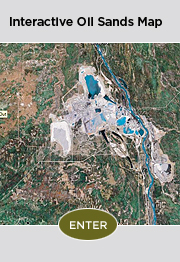Environment
Few other industries have environmental performance, social performance and business performance so closely linked as they are in oil sands development. According to the latest edition of World Energy Outlook, global demand for energy is increasing and will grow by 50 per cent by 2030. The demand for greater environmental responsibility is also increasing. Oil sands developers believe energy production and environmental responsibility are demands that can be balanced within our industry. It simply makes good business, social and environmental sense to do so. In general, the less oil sands projects emit and consume, the more productive and efficient they become.
Oil sands developers have invested in solutions to reduce emissions, to return the land it borrows to a self-sustaining state, and to minimize the use of fresh water. The industry has a proven history of incremental and step-change environmental improvements even as production volumes have increased. The industry is monitored through unique multi-stakeholder processes that include government, environmental groups, First Nations and Métis communities. The Government of Alberta, and in some cases the Government of Canada, regulates the development and activities of oil sands operators. The oil sands industry also continues to pioneer research and invest in technology aimed at improving current and future environmental performance.




















